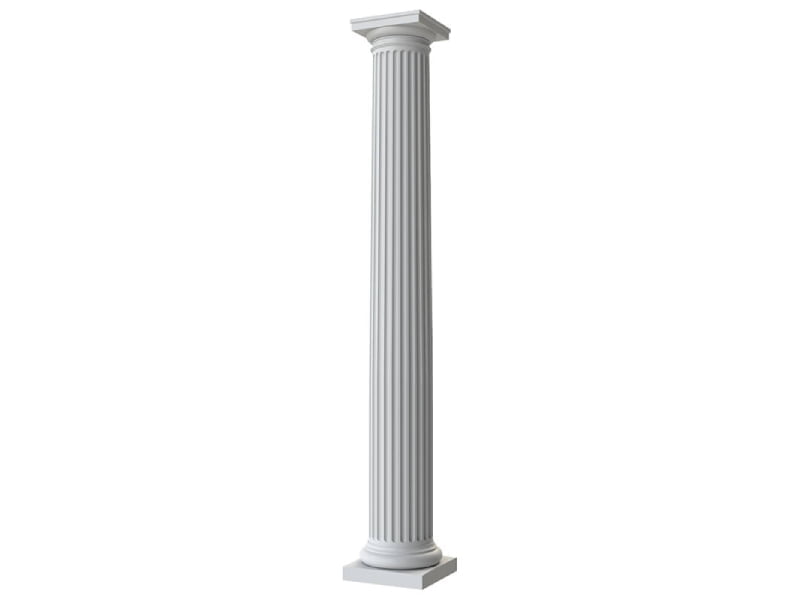
Fiberglass columns have become a prominent choice in the world of architecture and construction due to their exceptional durability, versatility, and aesthetic appeal. These columns, constructed using a combination of fine glass fibers and resin, offer an array of benefits that make them an attractive option for both interior and exterior applications. This comprehensive exploration delves into the various aspects of fiberglass columns, shedding light on their definition, advantages, installation, maintenance, selection criteria, diverse types, cost considerations, durability factors, and the manifold benefits they bring to home construction.
What Are Fiberglass Columns?
Fiberglass columns, at their core, are structural elements composed of a composite material that blends glass fibers and resin. This amalgamation of materials leads to a highly durable and lightweight product that replicates the aesthetic characteristics of traditional architectural materials like stone or wood. Designed to mimic various historical styles, these columns can be tailored to blend seamlessly into both classical and contemporary architectural designs, making them an essential component in enhancing the visual and structural integrity of buildings.

Why Use Fiberglass Columns?
The decision to employ fiberglass columns is underpinned by a multitude of reasons. Their lightweight nature ensures ease of handling during installation, without compromising on strength and longevity. Unlike natural materials, fiberglass is resistant to corrosion, moisture, and insects, resulting in columns that withstand the test of time, even in demanding environments. Additionally, fiberglass columns offer exceptional design flexibility, enabling architects and homeowners to select from an extensive range of sizes, styles, and finishes, thereby achieving their desired aesthetic while adhering to the structural requirements.
How To Install And Maintain Fiberglass Columns?
Installing fiberglass columns involves careful planning and execution. These columns typically consist of three main components: the capital (top), shaft (middle), and base (bottom). Installation can be achieved using various methods, such as direct embedment, flange mounting, or column covers. Proper installation ensures load distribution and stability. Maintenance requirements are minimal, involving periodic cleaning and inspection for any signs of damage. Regular checks ensure that the columns remain structurally sound and retain their visual appeal over the long term.
Tips For Choosing The Right Fiberglass Columns
Selecting the most appropriate fiberglass columns involves considering factors such as architectural style, load-bearing capacity, height, diameter, and design elements. Columns come in various styles, including Tuscan, Doric, Ionic, Corinthian, and more, each reflecting distinct historical periods. Assessing the load-bearing requirements is crucial to guarantee structural stability. Furthermore, coordinating the column size with the building’s proportions is essential to achieve a harmonious aesthetic outcome.
Different Types Of Fiberglass Columns
Fiberglass columns offer a diverse array of types, each catering to specific architectural styles and preferences. These encompass plain, fluted, tapered, non-tapered, round, square, and pilaster variations, allowing for seamless integration into various design schemes. Plain columns emphasize simplicity, while fluted columns feature vertical grooves that evoke elegance and sophistication. Tapered columns, narrower at the top, provide an illusion of height, making them a favorite in classical architecture. Non-tapered columns maintain a consistent diameter, fitting well in contemporary contexts. The wide variety of shapes and styles ensures that fiberglass columns can adapt to any design vision.
Cost And Durability Considerations For Fiberglass Columns
While fiberglass columns may have a higher upfront cost compared to certain other materials, their long-term benefits justify the investment. The inherent durability of fiberglass ensures that these columns remain unaffected by moisture, insects, and decay, resulting in minimal repair and replacement costs over time. Moreover, their lightweight composition facilitates easier transportation and installation, potentially reducing labor expenses. The ability to mimic the appearance of more expensive materials, such as stone or wood, makes fiberglass columns a cost-effective option without compromising on aesthetics.
Benefits Of Using Fiberglass Columns In Home Construction
The advantages of incorporating fiberglass columns into home construction are manifold. Beyond their aesthetic appeal and architectural versatility, these columns offer exceptional resistance to environmental factors like moisture, temperature fluctuations, and pests. Their low maintenance requirements translate to long-lasting beauty and structural reliability. The vast range of styles and sizes available enables homeowners to align their choices with their design preferences. Furthermore, fiberglass columns are eco-friendly due to their longevity and minimal waste production during manufacturing. This makes them a sustainable choice for environmentally conscious construction.
Conclusion
In the ever-evolving landscape of architectural design and construction, fiberglass columns emerge as a compelling solution, combining aesthetics, strength, and durability. From their composition that marries glass fibers with resin to their installation, maintenance, and various types, these columns stand as a testament to innovation and adaptability. Their cost-effectiveness, along with the myriad benefits they bring to the table, renders fiberglass columns an invaluable asset in the realm of home construction. Whether seeking to infuse a touch of timeless elegance or a contemporary flair, these columns offer a canvas on which architects and homeowners can paint their vision of architectural grandeur while embracing the reliability of modern material

Bethany Donovan is an experienced digital native from Kansas. She is passionate about all things tech related, and spends her free time researching the latest trends and innovations in the industry. Bethany has worked in the IT field for over 10 years, and currently works in an IT support role for a local government entity. She also runs her own blog for tech enthusiasts, sharing her insights and advice on topics from basic technology setup to complex software development.





